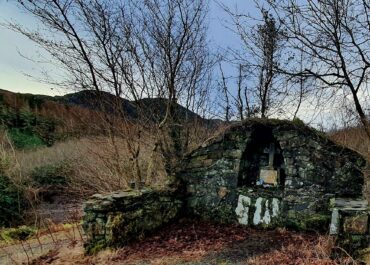Ritual site - holy/saint's stone, Straid (Straid Ed), Co. Donegal
In the townland of Straid in County Donegal, the ruins of an 18th century church stand within an old graveyard that marks what scholars believe to be the early ecclesiastical site of Culmaine.
Ritual site - holy/saint's stone, Straid (Straid Ed), Co. Donegal
The site occupies a strip of fertile ground amidst otherwise rough pasture that slopes northeast towards the Clonmany river, a setting that would have made it an attractive location for early religious settlement.
Just 14 metres from the southeast corner of the church lies one of the site’s most intriguing features: a flat stone measuring 30 by 52 centimetres, marked with two small cup-shaped depressions. Local tradition holds that these cupmarks are the knee prints of St. Colmcille (also known as St. Columba), presumably left behind when the saint knelt here in prayer. Such “body print” stones are found at various holy sites across Ireland, where they serve as tangible links between the landscape and the saints who supposedly walked, prayed, and performed miracles there.
The site has seen various phases of occupation over the centuries. Historical records from 1600 mention a castle, likely a fortified stone house, that stood beside the church and was inhabited by a priest named Amerson. Though this structure has completely vanished without a trace, its documented presence hints at the site’s continued religious significance well into the early modern period. Today, while the church lies in ruins and the castle has disappeared entirely, St. Colmcille’s knee prints remain, offering visitors a direct connection to centuries of faith and folklore.


